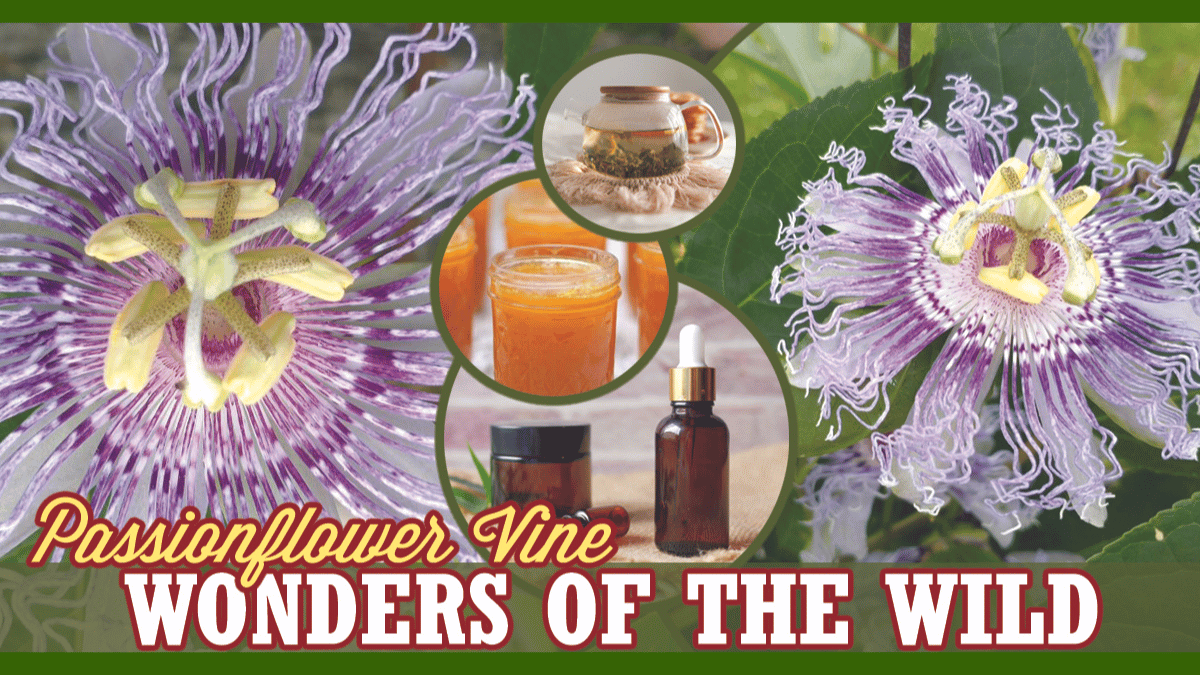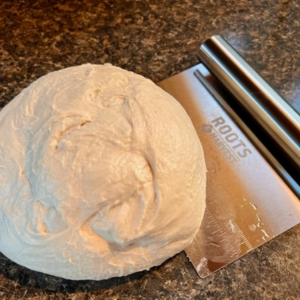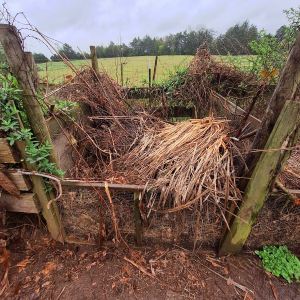
Share Knowledge.
Build Community.
Grow Friendships.
Passionflower Vine: Wonders of the Wild
Passionflower Vine

“...My love and I are one, and yet
Full oft my cheeks with tears are wet -
So sweet the night is and the bower!
My love gave me a passion-flower.”
- excerpt from The Passion Flower by Sarah Margaret Fuller 1845
The Passionflower vine (Passiflora incarnata) is an exquisite beauty to behold. I delight in watching the wonderment of others viewing the alluring violet blooms for the first time. A phenomenal stamen and carpel centerpiece encircled by funky porphyrous tendrils of the corona filament radiates into a breathtaking show often attributed exclusively to tropical flora.
From the Passifloraceae family, it is commonly known as Maypops, Ocoee, Purple Passion Vine, or Apricot Vine. Cherokee call it ᎤᏩᎦ (uwaga), and the term Maypop may have emanated from the Powhatan word mahcawq, meaning squash (which may have been a way to explain to Europeans the edibility, usefulness, and cultural significance of the fruit).
@themistymushroom Native wildflowers are simply gorgeous! #nativeplantsplease #nativeplanttok #themistymushroom #nativeplants #nativeplantpermaculture #savebiodiversity ♬ I Think I Am In Love - Nova
EDIBLE OPPORTUNITIES
The fruit of Passiflora incarnata is green, fleshy, egg-shaped, and fits in the palm of your hand. It slowly ripens into a crinkled/wrinkled yellow as it matures. Edible and highly desired over Yellow Passionflower for taste, it is best once ripe fruits have fallen from the vine. The fruit inside should have a yellow hue vs white (unripened packs a sour punch). Nutritionally, their values have not been evaluated. They likely share attributes with other tropical varieties high in vitamins A and C, with a chunk of protein and carbs included to make them worthy of foraging and consideration for sustainable crops on the homestead.
“The Houma, Cherokee and other Native American tribes used purple passionflower for food, drink, and medicinal purposes. Captain Smith, in 1612, reported that Native Americans in Virginia planted the vines for the fruits. The fruits were eaten either raw or boiled to make syrup. A beverage was made from the fruits by crushing and straining the juice. Sometimes the juice was thickened by mixing it with flour or cornmeal. The young shoots and leaves were eaten, cooked with other greens. The roots were used in an infusion to treat boils, and to “draw out inflammation” of wounds from briers or locusts (thorns). Babies were given a tea made from the roots to aid in weaning. The roots were beaten with warm water and used as eardrops to treat earaches. Root infusions were used to treat liver problems. Soaking the crushed roots in drinking water made a “blood tonic.” The plant was also used as a sedative to treat nervous conditions and hysteria.” - USDA NRCS Plant Guide
In the kitchen, the harvested fruit easily pops open, revealing the yellowish pulp with seeds. Using a spoon, scoop out the pulp from the rind (compost that green goodness) and place it into a saucepan filled with water (1/2 cup water to 1 cup pulp). Bring to a boil with an occasional stir, then reduce the heat and stir frequently for 5 minutes. Use a strainer and cheesecloth to squeeze out as much pulp from the seeds as possible. Seeds can be scattered where desired, consumed raw, roasted and eaten, or roasted/dehydrated and ground into a powder as a thickening agent for soups/stews/sauces.
With that glorious and scrumptious Passionflower fruit liquid gold, you can utilize it for a multitude of recipes, including drinks, smoothies, bread, sweets, and—of course—jelly and jams. Use one cup of fruit liquid with 1 cup of sugar and 50 grams of pectin. Using sterilized jars, process in a boiling water bath for 10 minutes, remove and allow for the glorious pings of cooling jar lids to incite a kitchen party tango.
HERBALISM
The Passionflower vine has been utilized as a hypnotic (sleep aid), anxiolytic (anti-anxiety), analgesic (pain-reliever), hypotensive (lowering blood pressure), antidepressant, anti-spasmodic, and a nervine. A sensational resource is the “Passionflower ( Passiflora ) An overview of the research and clinical indications” by Michael L Traub, detailing various clinical trials from around the world with positive usage of Passiflora Incarnata independently or combined with pharmaceuticals in treatment of numerous issues including symptoms of opiate withdrawal, pre-surgical anxiety, attention deficit hyperactivity disorder, palpitations, arrhythmia, hypertension, and even low libido.
To prepare for herbal remedies, ensure that plants haven’t been sprayed with chemicals. Use vital and green leaves, stems, and fresh flower buds picked early in the morning before 10 am. Roots can also be dug and cleaned for use. Passionflower can be incorporated dried or fresh in recipes and readily dries hung up or with a dehydrator.
For tinctures, use a 1:2 ratio with 95% chopped fresh herb or a 1:5 ratio with 50% dried herb. I prefer using 100-proof vodka as a staple for both dried and fresh (others use a higher proof for raw and lower proof for dried), putting the mixture into a jar, and shaking it daily for a month. Strain the finished product into vials and label it. A couple drops under the tongue is an easy start, using up to two dropper fulls daily.
For tea, a scoop of dried herb makes a relaxing brew alone or combined with another recipe of your choice. I recommend using it with chamomile flowers, mint, rose petals, and lemon balm as a good base that is easy on the herbal armoir and using honey for taste. Steep for 10 minutes at the least, but I often leave mine in the pot for 30 before enjoyment.
GOING FURTHER
The Passifloracea family has a variety of plants found across the Eastern and Southern USA, with Purple Passionflower being native within 23 states. A perennial with a vining habit can climb up to 25 feet long and lose leaves in the winter. It tolerates a wide range of soil, moisture levels, and hours of sunlight; it is adaptable and can be incorporated to create thickets due to the vivaciousness of the vine. Bloom time is dependent on the location and age of the vine. Still, it has continuous blooms from late spring to fall that easily give Clematis vines a run for their money.
Identification of the vine is easiest by viewing the aubergine blooms. The trident-shaped three-lobed leaves are as large as a hand and have two small bumps next to the leaf on the stem. These extrafloral nectaries attract ants but also serve as a deterrent from the blooms, which protects pollinators visiting for nectar and provides protection against caterpillars from dining heavily on the foliage.
Magnificent to look at, edible, medicinal, and also promoting a biodiverse landscape, Purple Passionflower is also the host plant for six different butterflies. The Gulf Fritillary is the most common, but you may also see the Red-banded Hairstreak and Variegated Fritillary. Bumblebees love to dance around the blooms, along with other pollinators.
Propagation from seed is doable, but germination can be low and recommended with outdoor sowing and exposure to 60 days of cold. The vine sends up various suckers from underground stems, so digging to get rootstock for planting should be done with care, as often underground stems are without roots and should be treated as cuttings. Direct cuttings of the vines are often the easiest for propagation. Heavy mulching is recommended in colder climates to protect it through the winter.
Links
Ants, Extrafloral Nectaries and Herbivory on the Passion Vine, Passiflora incarnata (1983) D. K. McLain
Reproductive biology and herbicidal sensitivity of maypop passionflower (Passiflora incarnata) (1985) G. Wehtje, R. B. Reed and R. R. Dute
The statements made on this blog have not been evaluated by the FDA and are not intended to diagnose, prescribe, recommend, or offer medical advice. Please see your health care practitioner for help regarding choices and to avoid herb-drug interactions.
Other Articles
P.O. Box 1190 Statham, GA 30666
All Rights Reserved | National Ladies Homestead Gathering, Inc.



